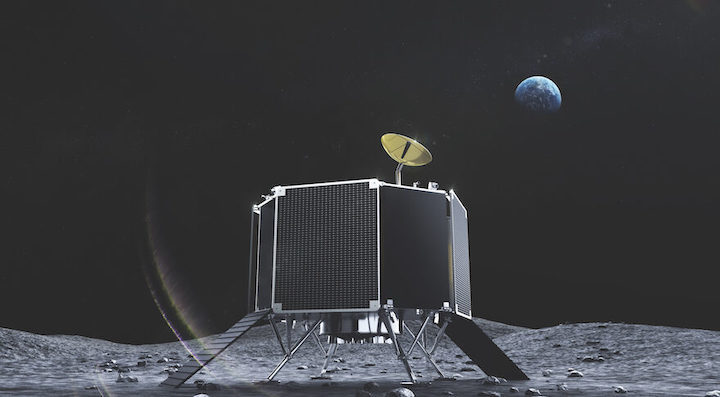25.08.2021

Updated 11:45 p.m. to correct lunar orbit payload.
COLORADO SPRINGS — Japanese lunar space transportation company ispace is developing its design for a larger lunar lander that will be built in the United States.
The Tokyo-based company unveiled the design of the lander at the 36th Space Symposium Aug. 23. The lander, being developed by the company’s U.S. office in Denver, will fly as soon as 2024 on the company’s third mission to the moon.
A major difference in the new design, company officials said in interviews, is the payload capacity. While the lander ispace is building for its first two missions in 2022 and 2023 can carry 30 kilograms of payload to the lunar surface, the new lander will have a payload capacity of 500 kilograms to the surface. It will also be able to deploy an additional 2,000 kilograms of payloads to lunar orbit.
“We took a deep dive on what is currently available in the market and things coming down the pipeline in the next 5 to 10 years,” said Kursten O’Neill, program director and engineering manager at ispace U.S. “We’re planning this lander to be something that can support the future of lunar exploration.”
Besides the increased payload capacity, ispace is designing the lander to survive the two-week lunar night. The lander will be able to land not just on the near side of the moon but also its far side and the poles, which will require a communications relay capability the company is still studying. The lander features modular accommodations intended to support a wide range of potential payloads, such as rovers.
O’Neill called the new lander an “evolution” of ispace’s original, smaller landers. “There are some things that are new,” she said. “As you grow in size, your structure changes and your propulsion system changes, but we’ve leveraged a lot of information and a lot of technical lessons learned.”
The lander recently passed a preliminary design review of the lander, allowing ispace to move into more detailed design work. “Our intention is to launch this within the first half of 2024,” said Kyle Acierno, chief executive of ispace U.S.
The company is partnering with General Atomics, who will handle assembly, integration and testing of the lander. Draper is providing the lander’s guidance, navigation and control system.
The lander will be entirely designed and built in the United States, a decision ispace said it took to compete for efforts like NASA’s Commercial Lunar Payload Services (CLPS) program. “To actually build it in the U.S. would make it more feasible to offer this to U.S. government customers,” O’Neill said. The company would provide lunar lander services to NASA through Draper, one of 14 companies currently part of CLPS.
Acierno said ispace has signed memorandums of understanding with more than a dozen prospective customers for the new lander, although the company has not disclosed their identities. “One of the reasons why we developed this larger lander is to fulfill the growing appetite that we see in the commercial market,” he said.
Work on the new lander is currently supported by a $46 million Series C funding round ispace announced Aug. 4. The company has raised $195.5 million to date. “Continuous funding is necessary to develop multiple future missions and we’re going to do what we need to continue to make progress,” Acierno said, but declined to discuss financing details.
The new lander is the exclusive focus of ispace’s U.S. office, which opened less than a year ago and now has about 30 employees. “We will continue hiring on both the engineering and business sides,” he said. “Our intention is to grow significantly over the next six months.”
“We’ve accomplished a lot in a short period of time,” O’Neill said. “I think it speaks to people believing in the vision of the company and wanting to move forward and help with the exploration of the lunar surface.”
Quelle: SN
